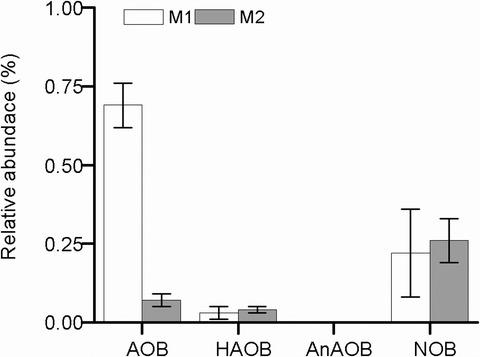当前位置:
X-MOL 学术
›
Microb. Biotechnol.
›
论文详情
Our official English website, www.x-mol.net, welcomes your feedback! (Note: you will need to create a separate account there.)
Impact of dissolved oxygen and loading rate on NH3 oxidation and N2 production mechanisms in activated sludge treatment of sewage
Microbial Biotechnology ( IF 5.7 ) Pub Date : 2020-06-02 , DOI: 10.1111/1751-7915.13599 Xueyu Zhang 1 , Shida Li 1 , Shaokui Zheng 1 , Shoupeng Duan 1
Microbial Biotechnology ( IF 5.7 ) Pub Date : 2020-06-02 , DOI: 10.1111/1751-7915.13599 Xueyu Zhang 1 , Shida Li 1 , Shaokui Zheng 1 , Shoupeng Duan 1
Affiliation

|
Microaerobic activated sludge (MAS) is a one‐stage process operated at 0.5–1.0 mg l−1 dissolved oxygen (DO) aiming at simultaneous nitrification and denitrification. We used molecular techniques and a comprehensive nitrogen (N)‐transformation activity test to investigate the dominant NH3‐oxidizing and N2‐producing mechanism as well as the dominant ammonia‐oxidizing bacteria (AOB) species in sludge samples individually collected from an MAS system and a conventional anoxic/oxic (A/O) system; both systems were operated at a normal loading rate (i.e. 1.0 kg chemical oxygen demand (COD) m−3 day−1 and 0.1 kg NH4+‐N m−3 day−1) in our previous studies. The DO levels in both systems (aerobic: conventional A/O system; microaerobic: MAS system) did not affect the dominant NH3‐oxidizing mechanism or the dominant AOB species. This study further demonstrated the feasibility of a higher loading rate (i.e. 2.30 kg COD m−3 day−1 and 0.34 kg NH4+‐N m−3 day−1) with the MAS process during sewage treatment, which achieved a 40% reduction in aeration energy consumption than that obtained in the conventional A/O system. The increase in loading rates in the MAS system did not affect the dominant NH3‐oxidizing mechanism but did impact the dominant AOB species. Besides, N2 was predominantly produced by microaerobic denitrification in the MAS system at the two loading rates.
中文翻译:

活性氧处理污泥中溶解氧和负载率对NH3氧化和N2产生机理的影响
微氧活性污泥(MAS)是一个阶段过程,在0.5–1.0 mg l -1溶解氧(DO)下运行,旨在同时进行硝化和反硝化作用。我们使用分子技术和全面的氮(N)转化活性测试来研究从MAS单独收集的污泥样品中占主导地位的NH 3氧化和N 2产生机理以及占优势的氨氧化细菌(AOB)物种。系统和常规的缺氧/有氧(A / O)系统;两种系统均以正常负荷率运行(即1.0 kg化学需氧量(COD)m -3 天-1和0.1 kg NH 4 + -N m -3 天-1)在我们以前的研究中。两种系统(需氧:常规A / O系统;微需氧:MAS系统)中的DO水平均不会影响主要的NH 3氧化机理或主要的AOB种类。这项研究进一步证明了在污水处理过程中,MAS工艺可提高装载量(即2.30 kg COD m -3 天-1和0.34 kg NH 4 + -N m -3 天-1)的可行性,该装载量可达到40%与传统的A / O系统相比,减少了通气能耗。MAS系统中负载率的增加不会影响主要的NH 3氧化机制,但会影响主要的AOB种类。另外,N2主要由MAS系统中的两个加载速率下的微好氧反硝化产生。
更新日期:2020-06-02
中文翻译:

活性氧处理污泥中溶解氧和负载率对NH3氧化和N2产生机理的影响
微氧活性污泥(MAS)是一个阶段过程,在0.5–1.0 mg l -1溶解氧(DO)下运行,旨在同时进行硝化和反硝化作用。我们使用分子技术和全面的氮(N)转化活性测试来研究从MAS单独收集的污泥样品中占主导地位的NH 3氧化和N 2产生机理以及占优势的氨氧化细菌(AOB)物种。系统和常规的缺氧/有氧(A / O)系统;两种系统均以正常负荷率运行(即1.0 kg化学需氧量(COD)m -3 天-1和0.1 kg NH 4 + -N m -3 天-1)在我们以前的研究中。两种系统(需氧:常规A / O系统;微需氧:MAS系统)中的DO水平均不会影响主要的NH 3氧化机理或主要的AOB种类。这项研究进一步证明了在污水处理过程中,MAS工艺可提高装载量(即2.30 kg COD m -3 天-1和0.34 kg NH 4 + -N m -3 天-1)的可行性,该装载量可达到40%与传统的A / O系统相比,减少了通气能耗。MAS系统中负载率的增加不会影响主要的NH 3氧化机制,但会影响主要的AOB种类。另外,N2主要由MAS系统中的两个加载速率下的微好氧反硝化产生。



























 京公网安备 11010802027423号
京公网安备 11010802027423号